| |||||
| Decades: | |||||
|---|---|---|---|---|---|
| See also: | |||||
This article lists events that occurred during 1949 in Estonia .
| |||||
| Decades: | |||||
|---|---|---|---|---|---|
| See also: | |||||
This article lists events that occurred during 1949 in Estonia .

The Baltic states or the Baltic countries is a geopolitical term, which currently is used to group three countries: Estonia, Latvia, and Lithuania. All three countries are members of NATO, the European Union, the Eurozone, and the OECD. The three sovereign states on the eastern coast of the Baltic Sea are sometimes referred to as the "Baltic nations", less often and in historical circumstances also as the "Baltic republics", the "Baltic lands", or simply the Baltics.
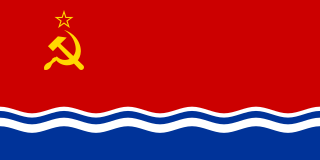
The Latvian Soviet Socialist Republic, also known as Soviet Latvia or simply Latvia, was a republic in the Soviet Union. The Latvian SSR existed for over 50 years, from 5 August 1940 to 6 September 1991.
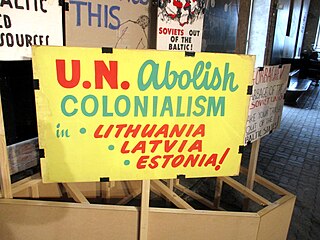
The three independent Baltic countries – Estonia, Latvia, and Lithuania – were invaded and occupied in June 1940 by the Soviet Union, under the leadership of Stalin and auspices of the Molotov–Ribbentrop Pact that had been signed between Nazi Germany and the Soviet Union in August 1939, immediately before the outbreak of World War II. The three countries were then annexed into the Soviet Union in August 1940. The United States and most other Western countries never recognised this incorporation, considering it illegal. On 22 June 1941, Nazi Germany attacked the Soviet Union and within weeks occupied the Baltic territories. In July 1941, the Third Reich incorporated the Baltic territory into its Reichskommissariat Ostland. As a result of the Red Army's Baltic Offensive of 1944, the Soviet Union recaptured most of the Baltic states and trapped the remaining German forces in the Courland Pocket until their formal surrender in May 1945.

The war crimes and crimes against humanity which were perpetrated by the Soviet Union and its armed forces from 1919 to 1991 include acts which were committed by the Red Army as well as acts which were committed by the country's secret police, NKVD, including its Internal Troops. In many cases, these acts were committed upon the orders of the Soviet leaders Vladimir Lenin and Joseph Stalin in pursuance of the early Soviet government's policy of Red Terror. In other instances they were committed without orders by Soviet troops against prisoners of war or civilians of countries that had been in armed conflict with the USSR, or they were committed during partisan warfare.

The Estonian government-in-exile was the formally declared governmental authority of the Republic of Estonia in exile, existing from 1944 until the reestablishment of Estonian sovereignty over Estonian territory in 1991 and 1992. It traced its legitimacy through constitutional succession to the last Estonian government in power prior to the Soviet invasion of 1940. During its existence, it was the internationally recognized government of Estonia.
Soviet deportations from Estonia were a series of mass deportations in 1941 and 1945–1951 carried out by the Stalinist regime of the former USSR from then Soviet-occupied Estonia. The two largest waves of deportations occurred in June 1941 and March 1949 simultaneously in all three occupied Baltic countries: Estonia, Latvia, and Lithuania. The deportations targeted primarily women, children and the elderly, calling them 'anti-Soviet elements'. In addition, there were Soviet deportations from Estonia based on the victims' ethnicity and religion. Ethnic Estonians who had been residing in Soviet Russia had already been subjected to deportation since 1935.
The June deportation was a mass deportation of tens of thousands of people from the territories which were occupied in 1940–1941: Estonia, Latvia, Lithuania, occupied Ukraine, and occupied Poland, and Moldavia by the Soviet Union.
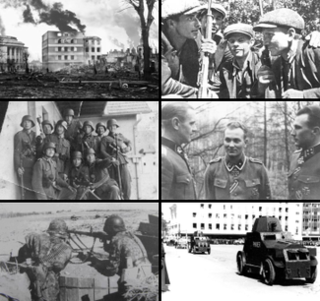
Estonia declared neutrality at the outbreak of World War II (1939–1945), but the country was repeatedly contested, invaded and occupied, first by the Stalinist Soviet Union in 1940, then by Nazi Germany in 1941, and ultimately reinvaded and reoccupied in 1944 by the Soviet Union.
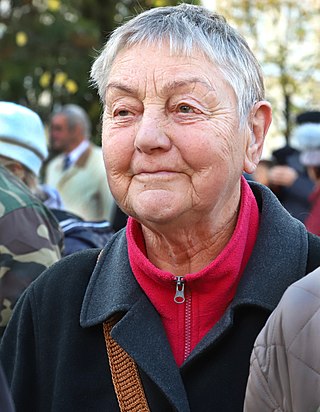
Lagle Parek is an Estonian politician. She served as the Minister of the Interior in the first post-soviet government, led by the Prime Minister Mart Laar.
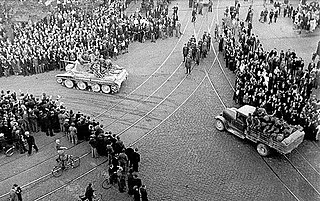
The Soviet occupation of Latvia in 1940 refers to the military occupation of the Republic of Latvia by the Soviet Union under the provisions of the 1939 Molotov–Ribbentrop Pact with Nazi Germany and its Secret Additional Protocol signed in August 1939. The occupation took place according to the European Court of Human Rights, the Government of Latvia, the United States Department of State, and the European Union. In 1989, the USSR also condemned the 1939 secret protocol between Nazi Germany and herself that had led to the invasion and occupation of the three Baltic countries, including Latvia.
Operation Priboi was the code name for the Soviet mass deportation from the Baltic states on 25–28 March 1949. The action is also known as the March deportation by Baltic historians. More than 90,000 Estonians, Latvians and Lithuanians, labeled as "enemies of the people", were deported to forced settlements in inhospitable areas of the Soviet Union. Over 70% of the deportees were either women or children under the age of 16.
Operation North was the code name which was assigned by the USSR Ministry of State Security to the massive deportation of Jehovah's Witnesses and their families to Siberia in the Soviet Union on 1 and 8 April 1951.

Estonian partisans, also called the Forest Brothers in Estonia were partisans who engaged in guerrilla warfare against Soviet forces in Estonia from 1940 to 1941 and 1944 to 1978.
The timeline of the occupation of the Baltic states lists key events in the military occupation of the three countries – Estonia, Latvia and Lithuania – by the Soviet Union and by Nazi Germany during World War II.

The Estonian Soviet Socialist Republic, also known as the Estonian SSR, Soviet Estonia, or simply Estonia, was a union republic and an ethnically based administrative subdivision of the former Soviet Union (USSR) covering the occupied and annexed territory of Estonia in 1940–1941 and 1944–1991. The Estonian SSR was nominally established to replace the until then independent Republic of Estonia on 21 July 1940, a month after the 16–17 June 1940 Soviet military invasion and occupation of the country during World War II. After the installation of a Stalinist government which, backed by the occupying Soviet Red Army, declared Estonia a Soviet constituency, the Estonian SSR was subsequently incorporated into the Soviet Union as a "union republic" on 6 August 1940. Estonia was occupied by Nazi Germany in 1941, and administered as a part of Reichskommissariat Ostland until it was reconquered by the USSR in 1944.

The three Baltic states – Estonia, Latvia and Lithuania – were re-occupied in 1944–1945 by the Soviet Union (USSR) following the German occupation. The Baltic states regained independence in 1990–1991.

The Soviet occupation of the Baltic states covers the period from the Soviet–Baltic mutual assistance pacts in 1939, to their invasion and annexation in 1940, to the mass deportations of 1941.

The guerrilla war in the Baltic states was an insurgency waged by Baltic against the Soviet Union from 1944 to 1956. Known alternatively as the "Forest Brothers", the "Brothers of the Wood" and the "Forest Friars", these partisans fought against invading Soviet forces during their occupation of the Baltic states during and after World War II. Similar insurgent groups resisted Soviet occupations in Bulgaria, Poland, Romania and Ukraine.

1944 is a 2015 Estonian war drama film directed by Elmo Nüganen. The film first premiered in February 2015 in Berlin, Germany, before its release in Estonia and other Northern European countries. It was selected as the Estonian entry for the Best Foreign Language Film at the 88th Academy Awards but it was not nominated.
Soviet deportations from Latvia were a series of mass deportations by the Soviet Union from Latvia in 1941 and 1945–1951, in which around 60,000 inhabitants of Latvia were deported to inhospitable remote areas of the Soviet Union, which had occupied the country in 1940 and again in 1944/1945. Similar deportations were organized by the Soviet regime in the fellow occupied Baltic states of Estonia and Lithuania at the same time.